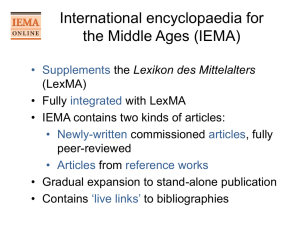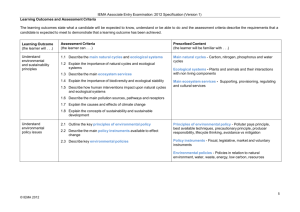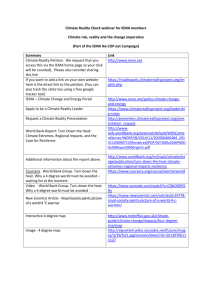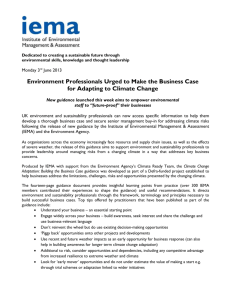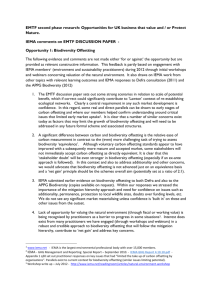430 Ill. Comp. Stat. §45.doc
advertisement
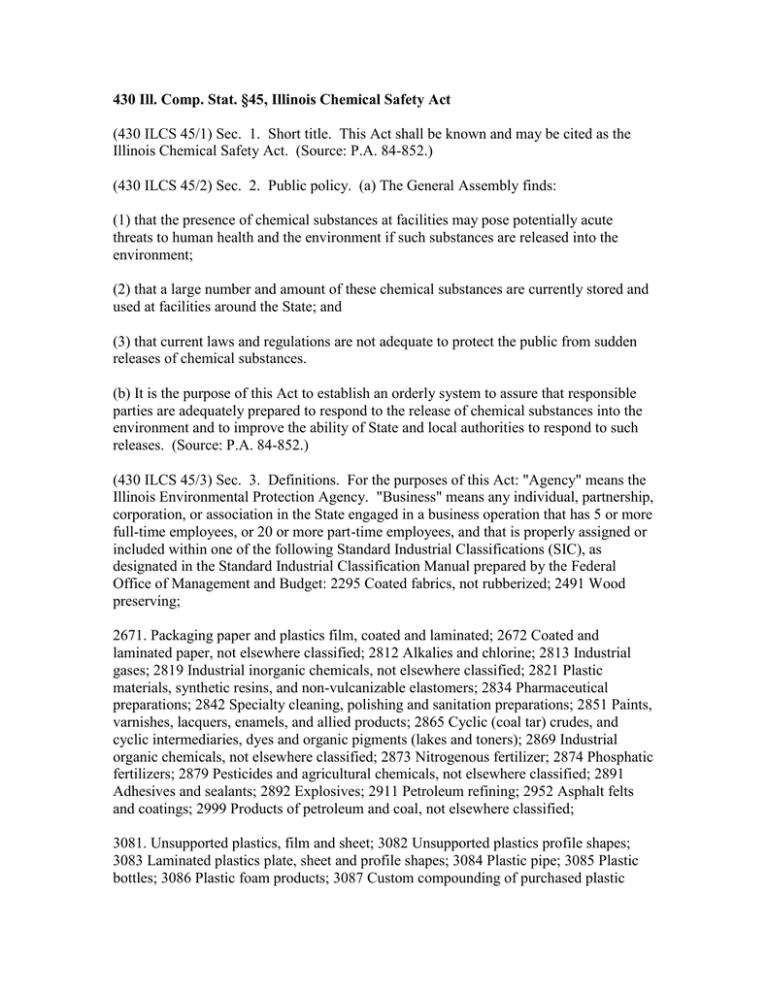
430 Ill. Comp. Stat. §45, Illinois Chemical Safety Act (430 ILCS 45/1) Sec. 1. Short title. This Act shall be known and may be cited as the Illinois Chemical Safety Act. (Source: P.A. 84-852.) (430 ILCS 45/2) Sec. 2. Public policy. (a) The General Assembly finds: (1) that the presence of chemical substances at facilities may pose potentially acute threats to human health and the environment if such substances are released into the environment; (2) that a large number and amount of these chemical substances are currently stored and used at facilities around the State; and (3) that current laws and regulations are not adequate to protect the public from sudden releases of chemical substances. (b) It is the purpose of this Act to establish an orderly system to assure that responsible parties are adequately prepared to respond to the release of chemical substances into the environment and to improve the ability of State and local authorities to respond to such releases. (Source: P.A. 84-852.) (430 ILCS 45/3) Sec. 3. Definitions. For the purposes of this Act: "Agency" means the Illinois Environmental Protection Agency. "Business" means any individual, partnership, corporation, or association in the State engaged in a business operation that has 5 or more full-time employees, or 20 or more part-time employees, and that is properly assigned or included within one of the following Standard Industrial Classifications (SIC), as designated in the Standard Industrial Classification Manual prepared by the Federal Office of Management and Budget: 2295 Coated fabrics, not rubberized; 2491 Wood preserving; 2671. Packaging paper and plastics film, coated and laminated; 2672 Coated and laminated paper, not elsewhere classified; 2812 Alkalies and chlorine; 2813 Industrial gases; 2819 Industrial inorganic chemicals, not elsewhere classified; 2821 Plastic materials, synthetic resins, and non-vulcanizable elastomers; 2834 Pharmaceutical preparations; 2842 Specialty cleaning, polishing and sanitation preparations; 2851 Paints, varnishes, lacquers, enamels, and allied products; 2865 Cyclic (coal tar) crudes, and cyclic intermediaries, dyes and organic pigments (lakes and toners); 2869 Industrial organic chemicals, not elsewhere classified; 2873 Nitrogenous fertilizer; 2874 Phosphatic fertilizers; 2879 Pesticides and agricultural chemicals, not elsewhere classified; 2891 Adhesives and sealants; 2892 Explosives; 2911 Petroleum refining; 2952 Asphalt felts and coatings; 2999 Products of petroleum and coal, not elsewhere classified; 3081. Unsupported plastics, film and sheet; 3082 Unsupported plastics profile shapes; 3083 Laminated plastics plate, sheet and profile shapes; 3084 Plastic pipe; 3085 Plastic bottles; 3086 Plastic foam products; 3087 Custom compounding of purchased plastic resin; 3088 Plastic plumbing fixtures; 3089 Plastic products, not elsewhere classified; 3111 Leather tanning and finishing; 3339 Primary smelting and refining of nonferrous metals, except copper and aluminum; 3432 Plumbing fixture fittings and trim; 3471 Electroplating, plating, polishing, anodizing and coloring; 4953 Refuse systems; 5085 Industrial supplies; 5162 Plastic materials and basic forms and shapes; 5169 Chemicals and allied products, not elsewhere classified; 5171 Petroleum bulk stations and terminals; 5172 Petroleum and petroleum products, wholesalers, except bulk stations and terminals. For the purposes of this Act, the SIC Code that a business uses for determining its coverage under The Unemployment Insurance Act shall be the SIC Code for determining the applicability of this Act. On an annual basis, the Department of Employment Security shall provide the IEMA with a list of those regulated facilities covered by the above mentioned SIC codes. "Business" also means any facility not covered by the above SIC codes that is subject to the provisions of Section 302 of the federal Emergency Planning and Community Right-to-Know Act of 1986 and that is found by the Agency to use, store, or manufacture a chemical substance in a quantity that poses a threat to the environment or public health. Such a determination shall be based on an on-site inspection conducted by the Agency and certified to the IEMA. The Agency shall also conduct inspections at the request of IEMA or upon a written request setting forth a justification to the IEMA from the chairman of the local emergency planning committee upon recommendation of the committee. The IEMA shall transmit a copy of the request to the Agency. The Agency may, in the event of a reportable release that occurs at any facility operated or owned by a business not covered by the above SIC codes, conduct inspections if the site hazard appears to warrant such action. The above notwithstanding, any farm operation shall not be considered as a facility subject to this definition. Notwithstanding the above, for purposes of this Act, "business" does not mean any facility for which the requirements promulgated at Part 1910. 119 of Title 29 of the Code of Federal Regulations are applicable or which has completed and submitted the plan required by Part 68 of Title 40 of the Code of Federal Regulations, provided that such business conducts and documents in writing an assessment for any instance where the Agency provides notice that a significant release of a chemical substance has occurred at a facility. Such assessment shall explain the nature, cause and known effects of the release, any mitigating actions taken, and preventive measures that can be employed to avoid a future release. Such assessment shall be available at the facility for review within 30 days after the Agency notifies the facility that a significant release has occurred. The Agency may provide written comments to the business following an on-site review of an assessment. "Chemical name" means the scientific designation of a chemical in accordance with the nomenclature system developed by the International Union of Pure and Applied Chemistry (IUPAC) or the American Chemical Society's Chemical Abstracts Service (CAS) rules of nomenclature, or a name that will clearly identify the chemical for hazard evaluation purposes. "Chemical substance" means any "extremely hazardous substance" listed in Appendix A of 40 C.F.R. Part 355 that is present at a facility in an amount in excess of its threshold planning quantity, any "hazardous substance" listed in 40 C.F.R. Section 302.4 that is present at a facility in an amount in excess of its reportable quantity or in excess of its threshold planning quantity if it is also an "extremely hazardous substance", and any petroleum including crude oil or any fraction thereof that is present at a facility in an amount exceeding 100 pounds unless it is specifically listed as a "hazardous substance" or an "extremely hazardous substance". "Chemical substance" does not mean any substance to the extent it is used for personal, family, or household purposes or to the extent it is present in the same form and concentration as a product packaged for distribution to and use by the general public. "IEMA" means the Illinois Emergency Management Agency. "Facility" means the buildings and all real property contiguous thereto, and the equipment at a single location used for the conduct of business. "Local emergency planning committee" means the committee that is appointed for an emergency planning district under the provisions of Section 301 of the federal Emergency Planning and Community Right-to-Know Act of 1986. "Release" means any sudden spilling, leaking, pumping, pouring, emitting, escaping, emptying, discharging, injecting, leaching, dumping, or disposing into the environment beyond the boundaries of a facility, but excludes the following: (a) Any release that results in exposure to persons solely within a workplace, with respect to a claim that such persons may assert against their employer. (b) Emissions from the engine exhaust of a motor vehicle, rolling stock, aircraft, vessel, or pipeline pumping station engine. (c) Release of source, byproduct, or special nuclear material from a nuclear incident, as those terms are defined in the Atomic Energy Act of 1954, if the release is subject to requirements with respect to financial protection established by the Nuclear Regulatory Commission under Section 170 of the Atomic Energy Act of 1954. (d) The normal application of fertilizer. "Significant release" means any release which is so designated in writing by the Agency or the IEMA based upon an inspection at the site of an emergency incident, or any release which results in any evacuation, hospitalization, or fatalities of the public. (Source: P.A. 90-442, eff. 8-16-97; 90-773, eff. 8-14-98.) (430 ILCS 45/4) Sec. 4. Chemical Safety Contingency Plans. (a) After July 1, 1986, no business shall operate a facility without a written Chemical Safety Contingency Plan unless exempted from this requirement under subsection (f) or otherwise included under the requirements of subsection (g) of this Section. At least one copy of the current plan shall be maintained at the facility at all times. The plan shall be reviewed by the business no less than annually, and changes from the previous year's plan shall be clearly identified, if such changes are necessary. (b) The Chemical Safety Contingency Plan shall, at a minimum, include the following: (1) A listing of the chemical substances that may be released at the facility, including both the chemical names and corresponding trade names, if any, and a brief description of the manner in which the substances are stored and used. This listing is not intended to include substances that are reasonably expected to be innocuous under the circumstances of their use or any release. In the case of mixtures of substances, the business may rely upon labeling in determining the need for listing. (2) Information on the probable nature and routes of any releases of these substances, and the possible causes of any of the releases. (3) The response procedures to be followed at the facility and for notifying local emergency response agencies, including but not limited to on-site alarm systems, on-site evacuation plans, and arrangements made under Section 5 to coordinate emergency services with local police departments, fire departments, hospitals, and other local emergency response agencies. (4) A list of names, addresses, and phone numbers (office and home) of appropriate persons qualified to act as the facility's emergency coordinator and alternate coordinator; if more than 2 persons are listed, the persons must be listed in the order in which they will assume responsibility as alternates. (5) A list of emergency equipment at the facility, such as fire extinguishing systems and decontamination equipment, including the location and description of each item of equipment. (c) No later than July 1, 1986, and whenever the plan is changed, one copy of the current Chemical Safety Contingency Plan for each facility shall be provided by each business to the appropriate local fire, police or other emergency response agency as determined by the local response plan or by agreement. After submission, the plan shall be made available for inspection by the public during normal operating hours. The IEMA may by rule under Section 5 of this Act require the business to provide copies of the Chemical Safety Contingency Plan to additional entities. (d) For each facility, a business shall notify IEMA of compliance with subsection (c) no later than July 15, 1986, and whenever the plan is changed. (e) On an annual basis, the appropriate local response agency may notify a business in writing that a chemical substance, that is not listed in the plan but is present at the facility, must be included within 60 days. In issuing the notice, the local response agency shall consider the quantity, phase (gas, liquid or solid) and relative toxicity of the chemical substance, and the potential for a release to result in acute impacts on human health or the environment. The requirement shall be binding upon the business unless, within 15 days of receipt of the notification, the business submits to the IEMA a written request for reconsideration, including the reasons therefor. In consultation with the Agency, the IEMA shall, within 30 days of the receipt of the request, notify the business and the local response agency in writing regarding the final determination. This final determination shall take effect following the 35th day after receipt by the business of notice of the determination, unless prior to such date the business or the local response agency files a petition for review of the decision under the Administrative Review Law. (f) The IEMA may issue an exemption to a business from the requirements of subsection (a) for any facility that uses, stores, or manufactures any chemical substance in an innocuous amount that is not likely to result in a release that threatens the environment or the public health. An exemption shall be issued only on the basis of an on-site inspection of the facility conducted by the Agency, or upon written certification by the business that is verified by the Agency, and certified to the IEMA after providing 60 days notice to the appropriate local emergency planning committee. If an objection to the exemption is filed by the local emergency planning committee, the IEMA may not further act until the objection is resolved. The IEMA may cancel any exemption at any time by sending written notice to the business that operates the facility. If action is taken to cancel an exemption, the business shall comply with subsection (a) within 90 days. A business that has been granted an exemption for a facility shall notify the IEMA within 30 days after using, storing, or manufacturing any chemical substance in greater than innocuous amounts. (g) No business, that has been notified in writing by the IEMA of the applicability of this Act under the last paragraph of the definition of "business" in Section 3, shall operate a facility after 90 days after the receipt of the notification without a written Chemical Safety Contingency Plan. The plan shall, at a minimum, include the following: (1) A listing of those extremely hazardous substances, that are present in an amount in excess of the threshold planning quantity, as defined by the Federal Emergency Planning and Community Right-to-Know Act of 1986, unless the business is a chemical and allied products terminal (SIC 5169) or a petroleum and petroleum products wholesaler/terminal (SIC 5172). For these types of terminal facilities, the listing shall include those chemical substances as required under paragraph (1) of subsection (b), except that the substances that are present at a facility for not more than 14 consecutive days may be listed categorically by USDOT Hazard Class. (2) The information, procedures, and listings as required under paragraphs (2), (3), (4), and (5) of subsection (b). At least one copy of the current plan shall be maintained at each facility at all times, and the plan shall be reviewed by each business no less often than annually. Upon initial preparation, and whenever the plan is changed, one copy of the current plan shall be provided by each business to the appropriate local fire, police, or other emergency response agency. For each facility, a business shall notify IEMA of compliance with this subsection no later than 15 days after the initial 90 day period, and whenever the plan is changed. (Source: P.A. 90-442, eff. 8-16-97.) (430 ILCS 45/4.1) Sec. 4.1. Local districts. Upon the request of any home rule unit with a population of at least 70,000, the Illinois Emergency Management Agency shall designate a local government as a local emergency planning district under the requirements of Section 301 of the federal Emergency Planning and Community Rightto-Know Act of 1986. (Source: P.A. 87-168.) (430 ILCS 45/5) Sec. 5. Regulations. The IEMA shall adopt regulations that specify coordination that shall take place between business and local emergency response agencies and other emergency response entities. The regulations shall, at a minimum: (1) Identify the categories and geographical jurisdiction of local emergency response agencies in the State. (2) Specify minimum requirements and procedures for communicating and coordinating with local emergency response agencies and other emergency response entities, including hospitals, police, and fire authorities. (3) Prescribe the forms and procedures for providing notices to IEMA under subsection (d) of Section 4 of this Act. (4) Establish procedures for notifying a 24 hour local emergency agency and residents of an affected geographical area within 48 hours of a significant release being reported to IEMA or any other reported release that IEMA determines to be of a sufficiently hazardous nature to warrant notification of a local emergency agency and nearby residents within the 48 hour time period. (Source: P.A. 87-168.) (430 ILCS 45/6) Sec. 6. Employee education program. (a) By January 1, 1987, every business required to develop a Chemical Safety Contingency Plan for a facility shall develop and implement an employee education program to ensure that all personnel responsible for implementing the Chemical Safety Contingency Plan at that facility are familiar with the procedures to be followed if there is a release of a chemical substance, unless otherwise included under the requirements of subsection (b) of this Section. The program shall include annual instruction of the appropriate employees on the plan, and documentation that the action has been completed. (b) Every business, that has been notified in writing by the IEMA of the applicability of this Act under the last paragraph of the definition of "business" in Section 3, shall comply with the provisions of subsection (a) of this Section within 180 days of the receipt of the notification. (Source: P.A. 87-168.) (430 ILCS 45/7) Sec. 7. Review of response actions and revisions of plans. (a) Any business that has a significant release of a chemical substance from a facility shall provide a written report to the Agency within 30 days of the incident or of designation thereof by the Agency or the IEMA. The report shall include a copy of the Chemical Safety Contingency Plan unless a copy of the current plan has been previously provided to the Agency, and shall explain the nature, cause, and known effects of the release, the actions taken to mitigate the effects of the release, and an assessment of the response actions and the Chemical Safety Contingency Plan. After submission to the Agency, the report shall be made available to the public under the Freedom of Information Act. (b) The Agency shall evaluate the report and any necessary supplemental information regarding the on-scene circumstances, actions, and results associated with the incident. Within 60 days of the receipt of the report, the Agency shall provide to the IEMA the report, the supplemental information and, if appropriate, any written findings and recommended revisions that the Agency considers necessary to improve the plan. The findings and recommendations shall be made available to the public under the Freedom of Information Act. (c) The IEMA shall review the submission provided by the Agency and determine if the Chemical Safety Contingency Plan meets the provisions of subsection (b) of Section 4, was properly adhered to, and what improvements could be provided to address such an incident. Within 60 days of receipt of the submission, the IEMA may require, by written notice, the business to revise the plan in accordance with the specified terms and schedule as are necessary to improve the plan. In issuing notice, IEMA shall consider the nature of the facility, the actual and potential impacts of the release, the character of the area including surrounding land uses, and the technical feasibility and economic reasonableness of the revision. The notice shall be made available to the public under the Freedom of Information Act. (d) Any required revision shall be binding upon the business unless, within 30 days of receipt of the notification, the business submits to the IEMA a written request for reconsideration, including the reasons therefor and, if appropriate, any alternative proposal for improving the plan. (e) Within 30 days after receipt of a request for reconsideration, the IEMA shall make a final determination in writing that affirms, rejects, or modifies the required revision of the plan. This final determination shall take effect following the 35th day after receipt by the business of notice of the determination, unless before that date the business files a petition for review of the decision under the Administrative Review Law. The determination shall be made available to the public under the Freedom of Information Act. (f) When, after a significant release, measures are taken by a business that, if taken previously, would have made the release less likely to occur, evidence of the subsequent measures is not admissible to prove negligence or culpable conduct in connection with the release. This subsection does not require the exclusion of evidence of subsequent measures when offered for another purpose, such as proving ownership, control, or feasibility of precautionary measures, if controverted, or for impeachment. (Source: P.A. 87-168.) (430 ILCS 45/8) Sec. 8. Confirmation and review of plans. (a) Authorized employees of the Agency, the IEMA and local emergency response agencies identified under Section 5 shall have authority to enter at all reasonable times any business facility subject to this Act for the purpose of ascertaining the existence of a written Chemical Safety Contingency Plan and confirming that it is readily available for use by designated facility personnel. During the visitation of a facility, the Agency may review the contents of a plan for consistency with the provisions of subsection (b) of Section 4. (b) The IEMA may require a business to, within 30 days, submit a copy of the Chemical Safety Contingency Plan for a facility to the Agency if any one of the following events occur: (1) The Agency conducts an on-site review under subsection (a) of this Section, that indicates a need for improved emergency planning and so notifies the IEMA in writing; or (2) The IEMA receives a written statement from a local emergency planning committee which confirms that a business has refused to participate or cooperate in the emergency planning process required under Section 303 of the federal Emergency Planning and Community Right-to-Know Act of 1986. (c) Upon receipt of the plan, the Agency shall review the plan and prepare written findings and recommendations, including any revisions that may be necessary to improve the plan. The information shall be sent to the business, the IEMA and the local emergency planning committee. Upon receipt of the information from the Agency, the business shall consider any specified revisions and initiate appropriate follow-up action to improve the plan as expeditiously as possible. The findings and recommendations by the Agency shall be made available to the public under the Freedom of Information Act. (d) At any time after the 120th day following the date the Agency sends the findings and recommendations to the business, the Agency may provide notice to the IEMA if there is confirmation that the business has been substantially deficient in addressing the recommended revisions. (e) The IEMA shall review the notice and related information provided by the Agency. Following the review, the IEMA, by written notice, may require the business to revise the plan in accordance with specified terms and schedule as are necessary to improve the plan. In issuing the notice, the IEMA shall consider the nature of the facility, the potential for releases and adverse impacts, any actions already taken by the business and the technical feasibility and economic reasonableness of the revisions. (f) Any required revision shall be binding upon the business unless, within 30 days of receipt of the notification, the business submits to the IEMA a written request for reconsideration, including the reasons and, if appropriate, any alternative proposal for improvements in the plan. (g) Within 30 days after receipt of a request for reconsideration, the IEMA shall make a final determination in writing that affirms, rejects, or modifies the required revision of the plan. This final determination shall take effect following the 35th day after receipt by the business of notice of the determination, unless prior to that date the business files a petition for review of the decision under the Administrative Review Law. (Source: P.A. 87-168.) (430 ILCS 45/9) Sec. 9. Informational and Technical Assistance Program. (a) The IEMA and the Agency shall develop an informational and technical assistance program relating to the implementation of this Act. (b) Upon request by a business, the Agency may provide technical assistance relating to emergency preparedness. The assistance may include provision of relevant guidance materials, identification of potential hazards associated with releases of chemical substances, and information regarding currently available emergency response procedures, practices, equipment, and supplies. (c) On or before February 1 of each year, the IEMA shall publish a report summarizing by county for the preceding calendar year: (1) The status of notifications provided by businesses under Section 4. (2) Information on significant releases. (3) Information on enforcement actions taken under Section 11. (4) The status of emergency preparedness planning and activities by communities in which businesses that are subject to the provisions of this Act are located. (d) The IEMA shall provide copies of the annual report to the appropriate local units of government. These local governments and agencies shall maintain a copy of each annual report, which shall be available for inspection by the public. (Source: P.A. 86-548; 87168.) (430 ILCS 45/10) Sec. 10. Trade secret information. Disclosure to the public of any information required to be provided under this Act which is claimed to be a trade secret or confidential business information, shall be subject to the provisions of the Freedom of Information Act. (Source: P.A. 84-852.) (430 ILCS 45/11) Sec. 11. Enforcement. (a) The Agency shall have the authority to investigate alleged violations of subsection (a) of Section 4, Section 6, subsection (a) of Section 7, and subsection (a) of Section 8, and, following written notice to the business, to refer violations for prosecution by the State's Attorney of the county in which the violation occurred, or by the Attorney General. The State's Attorney or the Attorney General, as the case may be, may, at the request of the Agency or on his own motion, institute a civil action for the penalties as are authorized by this Act, as well as other remedies, including injunctive relief, as are necessary to restrain or remedy violations of this Act. (b) The IEMA shall have the authority to investigate alleged violations of subsections (c), (d) and (e) of Section 4, subsection (c) of Section 7, and subsections (b) and (e) of Section 8, and, following written notice to the business, to refer the violations for prosecution by the State's Attorney of the county in which the violation occurred, or by the Attorney General. The State's Attorney or the Attorney General, as the case may be, may, at the request of IEMA or on his own motion, institute a civil action for penalties as are authorized by this Act, as well as for other remedies, including injunctive relief, as are necessary to restrain or remedy violations of this Act. (c) When alleged violations of this Act have been referred to the Attorney General or a State's Attorney, the Chairman of the County Board of the county and the chief executive officer of any municipality in which the alleged violations occurred shall be notified in writing by either the Agency or the IEMA. (Source: P.A. 87-168.) (430 ILCS 45/12) Sec. 12. Penalties. Any business which operates in violation of this Act shall be liable for a civil penalty not to exceed $10,000 for each violation, and an additional civil penalty not to exceed $1,000 for each day during which such violation continues. (Source: P.A. 84-852.)
